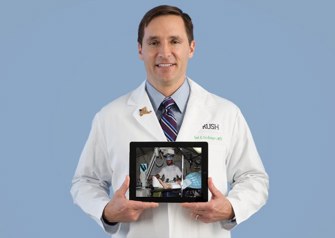
News
Call of Duty: Providing Surgical Care in Combat Zones
Date posted: 11/14/2017
Last updated: 11/14/2017
Table of Contents
My first deployment was to Kosovo with Task Force Falcon, Operation Joint Guardian, in 2001. Three weeks after 9/11, I was deployed from Fort Bragg with the 274th Forward Surgical Team (Airborne) — the first FST sent into Afghanistan — for Operation Enduring Freedom. Two years later, I was part of the Joint Special Operations Task Force in the initial actions of Operation Iraqi Freedom. And I returned to Afghanistan in 2011 with the 936th Forward Surgical Team and served with the Norwegian Provincial Reconstruction Team. That was my last deployment.
Targeting civilians
In armed conflict, the vast majority of casualties and injuries are the locals — the civilian population. That was true for the conflicts in Afghanistan and Iraq back when I served, and it’s true today in countries like Syria. What’s happening in Syria with ISIS, where they’re using human shields, was very common for Al Qaeda, too.
In 2011, our special mission unit went in to get a high value target in northern Afghanistan. After our soldiers surrounded the compound, they asked the enemy to send out all of the noncombatants. As soon as all of the women and children had come out into the courtyard and our soldiers had gone out to secure them to safety, the enemy threw grenades at the entire group. So the majority of the casualties from that mission were women and children — and, of course, our soldiers were injured trying to protect the families of the men who threw the grenades.
I don’t think most people in the U.S. can truly appreciate that kind of utter disregard for human life and sanctity of family. Nobody is a noncombatant to Al Qaeda or ISIS. They have no problem feeding their own families to the fire.
Treating the aftermath
You never forget seeing children and women blown apart. In 2011, I was stationed at Forward Operating Base Meymaneh with a small surgical team. The morning of our first day, we were supposed to begin training with the Norwegians who were running the local hospital; we were going to run through trauma scenarios. Just as we were having coffee and talking through the scenarios, there was a suicide bombing in the local village, and we had 15 to 20 casualties right away. One infant died with shrapnel wounds to his head, and multiple children were injured. These innocent people had been gathered in the town center going about their business, and then someone walked into the village with a bomb strapped to his chest.
During my deployments, I’ve treated everything from blasts to penetrating wounds to blunt traumas, and also more typical orthopedic injuries: We saw a lot of broken bones and dislocations from falls or from hard landings while troops were parachuting in. The one thing that’s very different than in the U.S. is the blast injuries. I can remember seeing my first landmine casualty, what that injury looks like. I remember there was a Canadian reporter who was riding downtown in Kabul, and a terrorist dropped a hand grenade in her lap through the car window, and the grenade blew up. That was a catastrophic injury. There was also a Norwegian soldier who was disarming a landmine and had his face shield up, and the landmine blew up in front of his face. I can still remember what that looked like.
Survival skills
It’s extremely hard to bear witness to the atrocities of war. But I think as a surgeon, it provides a very unique perspective to taking care of people here in the U.S. When it comes to doing an elective procedure — a hip replacement or knee replacement — I don’t think much gets me rattled in the operating room. Nobody is shooting at me, or at the building in which I’m operating, and I’m not treating the types of catastrophic injuries you see in combat.
Medical personnel in general are probably the best equipped of anyone in the military to deal with these injuries, because we treated traumatic injuries before our deployments. We’re used to taking care of people who are severely injured. What I saw in Iraq and Afghanistan was at a completely different level, but as a surgeon, I appreciate those experiences because I had a role in helping improve the situation, whether it was an individual’s medical condition or the condition of the country.
Critical conditions
The facilities in which we had to provide care ran full spectrum, both in terms of proximity to combat and the facilities themselves. The first level or area in which you can provide surgical care — the first place where surgeons are on hand — is a forward surgical team. That’s typically 20 people: four surgeons, three registered nurses, two certified registered nurse anesthetists, an administrative officer, a detachment sergeant, three licensed practical nurses, three surgical techs, and three medics.
The FST is very far forward; it’s situated pretty close to the front lines, where the combat is. You want to be a very short helicopter or vehicle ride away from where people are being injured, because that’s where that golden hour comes into effect and our ability to save lives.
When we first arrived in Afghanistan in 2001, we were set up in a MiG hangar in Uzbekistan. It was an old concrete structure, and it was filthy, so we put up our tent inside the building in an effort to control the environment to some degree. We moved very shortly into Afghanistan proper, where we were set up in an old air traffic control tower built by the Soviets at Bagram Airfield. It had been bombed and was blown out, so we patched it up as best we could and tried to generate some heat because it was chilly. But we were basically treating patients — including performing surgery — in a bombed-out building.
I’ve also operated in tents, and in the back of airplanes and helicopters. So it can be that rustic, that challenging an environment. Or it can be like in 2011, where we had really nice facilities. It was like “M*A*S*H,” basically. The Norwegians had built a little combat support hospital with a one-room trauma bay and a one-room OR that accommodated two beds. It was solid like a bunker, with thick concrete walls and a protected overhead to shield us from mortars. It was also warm and well-lit, and had modern surgical equipment.
Off limits
We’re used to such a high level of care in the U.S., with access to all of the latest modern equipment. But you just don’t have the ability to perform these tremendous tertiary care procedures in Iraq or Afghanistan. There are limitations based on equipment and materials, but also, what’s a sustainable technology for the patient. For instance, if a patient needs an above-knee amputation, they’re never going to be able to get a prosthesis due to both availability and cost. And what if they’re eligible for a limb-salvage procedure: Do you have the ability to do bone transport and some of the other interventions that could save the leg? Chances are, you don’t have all the necessary technologies at your fingertips, as you would in the U.S.
Another limiting factor is infection. You can’t close wounds in combat zones or they will become infected, and then you have to deal with infection through debridement (the medical removal of dead or damaged tissue) and surgical care. We simply didn’t do procedures that were prone to infections — putting in implants, for instance. I was able to do some intramedullary nails and fracture fixation during my last deployment in 2011 because we had a sterile OR and could safely put in implants. But in most forward areas, there is no way you can safely do those types of things. There are data on disaster care from China after one of the earthquakes: They saw a tremendously high 50 percent complication rate when they used hardware.
Passing the torch
Even though I’m no longer in the military, I remain involved with the Society of Military Orthopedic Surgeons (SOMOS). While I was still in uniform, I helped establish a disaster response course for the American Academy of Orthopaedic Surgeons (AAOS) that was designed to prepare civilian surgeons to travel overseas. SOMOS already had a predeployment course for its military surgeons; surgeons take the course to help them prepare to transition from very modern, safe facilities to damage-control orthopedics in military combat zones. After the earthquake in Haiti, AAOS approached SOMOS about adapting our course for civilian surgeons who volunteer to provide care in disaster-ravaged areas, such as Haiti. I’m no longer directing the course, but AAOS still uses it to train American surgeons, and that’s really gratifying.
To serve and protect
Few people realize that the U.S. military is the largest humanitarian organization in the world, between disaster relief efforts and helping take care of the local populations in conflict zones. I was in Kabul in December 2001 when girls were able to attend school for the first time since the Taliban had taken over (after the Soviets left in 1989). I actually got to watch those girls walk to school. It was a truly remarkable thing, and it made you realize that you could make a difference.
Of course, I also witnessed a lot of tragedy. Not a day goes by that I don’t think about something I saw or did, someone I worked with, or someone who was injured or killed. Every time I hear the national anthem play, I think of the guys I served with who aren’t going to see their families, who aren’t watching the World Series, who aren’t able to see their kids grow up because they were trying to do something good and help others. I’ll carry those memories with me for the rest of my life.
